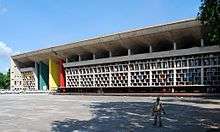Chandigarh
Chandigarh (local pronunciation: [tʃə̃ɳˈɖiːɡəɽʱ] (![]()
Chandigarh | |
|---|---|
Union territory and City | |
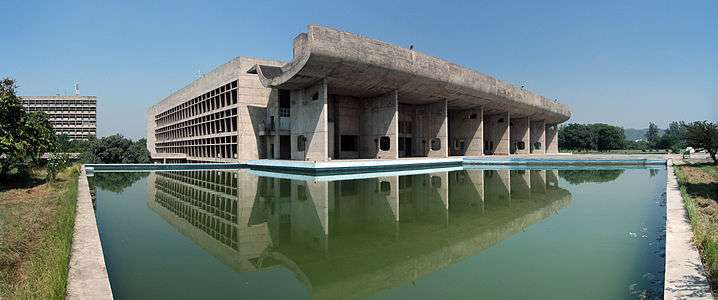 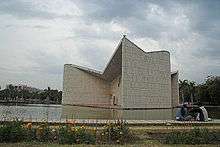   Clockwise from top left: Palace of Assembly, Rock Garden of Chandigarh, Sector 42 Stadium, Open Hand Monument and Gandhi Bhawan | |
 Seal | |
| Nickname(s): The City of Beauty[lower-alpha 1] | |
 Location of Chandigarh in India | |
| Coordinates: 30°45′N 76°47′E | |
| Country | |
| Formation of Union territory†† | 1 November 1966 |
| Government | |
| • Type | Union territory Municipality |
| • Body | Municipal Corporation Chandigarh |
| • Administrator | V.P. Singh Badnore |
| • Mayor | Arun Sood |
| • Adviser to Administrator | Manoj Parida, IAS |
| • Principal Secretary, Home | Arun Kumar Gupta, IAS |
| Area | |
| • Union territory | 114 km2 (44 sq mi) |
| Area rank | 35th in India |
| Elevation | 321 m (1,053 ft) |
| Population | |
| • Union territory | 1,055,450 |
| • Density | 9,262/km2 (23,988/sq mi) |
| • Metro | 1,025,682 (51st) |
| • Urban area | 1,611,770 |
| Language | |
| • Official | English[5] |
| Time zone | UTC+5:30 (IST) |
| PIN | 160XXX |
| Telephone code | +91-172-XXX-XXXX |
| ISO 3166 code | IN-CH |
| Vehicle registration | CH-01 (Current), CH-02 (Commercial Vehicles & Taxis), PB-01(Taxis to Chandigarh),[6] CH-03, CH-04 (Both Discontinued) |
| Effective literacy | 86.77% |
| HDI (2017) | |
| Website | chandigarh |
| †The city of Chandigarh comprises all of the union territory's area. ††under Section 4 of the Punjab Reorganisation Act, 1966. | |
| Symbols of Chandigarh | |
| Emblem | Open Hand Emblem |
| Mammal | Indian grey mongoose[8][9] |
| Bird | Indian grey hornbill |
| Flower | Dhak |
| Fruit | Mango |
| Tree | Mango Tree[9] |
Chandigarh is bordered by the state of Punjab to the north, the west and the south, and by the state of Haryana to the east. It is considered to be a part of the Chandigarh Capital Region or Greater Chandigarh, which includes Chandigarh, and the city of Panchkula (in Haryana) and cities of Kharar, Kurali, Mohali, Zirakpur (in Punjab). It is located 260 km (162 miles) north of New Delhi and 229 km (143 miles) southeast of Amritsar.
It was one of the early planned cities in post-independence India and is internationally known for its architecture and urban design.[10] The master plan of the city was prepared by Swiss-French architect Le Corbusier, which transformed from earlier plans created by the Polish architect Maciej Nowicki and the American planner Albert Mayer. Most of the government buildings and housing in the city were designed by the Chandigarh Capital Project Team headed by Le Corbusier, Jane Drew and Maxwell Fry. In 2015, an article published by BBC named Chandigarh as one of the few master-planned cities in the world to have succeeded in terms of combining monumental architecture, cultural growth, and modernisation.[11]
Chandigarh's Capitol Complex was in July 2016 declared by UNESCO as World Heritage at the 40th session of World Heritage Conference held in Istanbul. UNESCO inscription was under "The Architectural Work of Le Corbusier an outstanding contribution to the Modern Movement". The Capitol Complex buildings include the Punjab and Haryana High Court, Punjab and Haryana Secretariat and Punjab and Haryana Assembly along with monuments Open hand, Martyrs Memorial, Geometric Hill and Tower of Shadow and the Rock Garden.
The city has one of the highest per capita incomes in the country. The city is the cleanest in India based on a national government study.[12][13] The union territory also heads the list of Indian states and territories according to the Human Development Index.[14] In 2015, a survey by LG Electronics ranked it as the happiest city in India over the happiness index.[15][16][17] The metropolitan area of Chandigarh, Mohali and Panchkula collectively forms a Tricity, with a combined population of over 1,611,770.[18]
Etymology
The name Chandigarh is a compound of Chandi and Garh. Chandi refers to the Hindu goddess Chandi and Garh means fortress.[19] The name is derived from Chandi Mandir, an ancient temple devoted to the Hindu Goddess Chandi, near the city in Panchkula District.[20]
The motif or sobriquet of "The City of Beauty" was derived from the City Beautiful movement that was a popular philosophy in North American urban planning during the 1890s and 1900s. Architect Albert Mayer, the initial planner of Chandigarh, lamented the American rejection of City Beautiful concepts and declared "We want to create a beautiful city..."[21] The phrase was used on as a logo in official publications in the 1970s and is now how the city describes itself.[22][23]
History
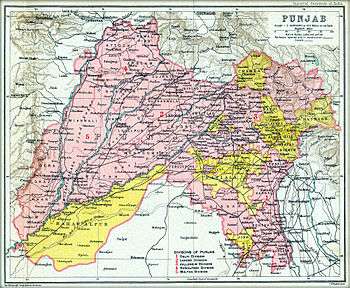
Chandigarh was the dream city of India's first Prime Minister, Jawaharlal Nehru. After the partition of India in 1947, the former British province of Punjab was divided into two provinces, East Punjab in India (mostly Sikhs and Hindus) and West Punjab in Pakistan (mostly Muslims).[24] The Indian Punjab required a new capital because the former capital, Lahore, had become part of Pakistan after the partition.[25][26] In 1949 the American planner and architect Albert Mayer was tasked to design a new city to be called "Chandigarh". The government carved out Chandigarh from about fifty Puadhi-speaking villages in the then-state of East Punjab, India.[27] Shimla was the temporary capital of East Punjab until Chandigarh was completed in 1960.
Albert Mayer developed a superblock-based city interspersed with green spaces which with an emphasis on cellular neighbourhoods and traffic segregation. His site-plan took advantage of natural land characteristics; the land's gentle grade promoted proper drainage. Mayer stopped work after his architect-partner Matthew Nowicki died in a plane crash in 1950. Government officials recruited Le Corbusier to succeed Mayer and Nowicki, who enlisted many elements of Mayer's original plan without attributing them to him.[28]
Le Corbusier designed many administration buildings, including the High Court, the Palace of Assembly, and the Secretariat Building. Le Corbusier also designed the general layout of the city, dividing it into sectors. Chandigarh hosts the largest of Le Corbusier's many Open Hand sculptures, standing 26 metres high. The Open Hand (La Main Ouverte) is a recurring motif in Le Corbusier's architecture, a sign for him of "peace and reconciliation. It is open to give and open to receive." It represents what Le Corbusier called the "Second Machine Age".[29] Two of the six monuments planned in the Capitol Complex which has the High Court, the Assembly, and the Secretariat, remain incomplete. These include Geometric Hill and Martyrs Memorial; drawings were made, and they were begun in 1956, but they were never completed.[30]
On 1 November 1966, the newly formed state of Haryana was carved out of the eastern portion of East Punjab, to create a new state for the majority Haryanvi-speaking people in that portion, while the western portion of East Punjab retained a mostly Punjabi-speaking majority and was renamed as Punjab. Chandigarh was located on the border of both states and the states moved to incorporate the city into their respective territories. However, the city of Chandigarh was declared a union territory to serve as capital of both states.[31]
As of 2016, many historical villages in Chandigarh are still inhabited within the modern blocks of sectors including Burail and Ottawa, while several non-sectoral villages lie on the outskirts of the city. These villages were a part of the pre-Chandigarh era.[32]
Geography and ecology
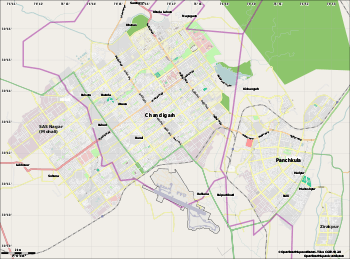
Location
Chandigarh is located near the foothills of the Sivalik Range of the Himalayas in northwest India. It covers an area of approximately 114 km2.[26] It borders the states of Haryana and Punjab. The exact geographic coordinates of Chandigarh are 30.74°N 76.79°E.[33] It has an average elevation of 321 metres (1053 ft).
The city, lying in the northern plains, includes a vast area of flat, fertile land. Its northeast covers sections of Bhabar and while the remainder of its terrain is part of the Terai.[34] The surrounding cities are Mohali, New Chandigarh, Patiala, Zirakpur and Rupnagar in Punjab, and Panchkula and Ambala in Haryana.
Chandigarh is situated 44 km (28 miles) northeast of Ambala, 229 km (143 miles) southeast of Amritsar, and 250 km (156 miles) north of Delhi.
Climate
Chandigarh has a humid subtropical climate (Köppen: Cwa) characterised by a seasonal rhythm: very hot summers, mild winters, unreliable rainfall and great variation in temperature (−1 °C to 46 °C OR 30.2 °F to 114 °F). The average annual rainfall is 1110.7 mm.[35] The city also receives occasional winter rains from the Western Disturbance originating over the Mediterranean Sea.
The western disturbances usually bring rain predominantly from mid-December till the end of April which can be heavier sometimes with strong winds and hails if the weather turns colder (during March–April months) which usually proves disastrous to the crops. Cold winds usually tend to come from the north near Shimla, capital of Himachal Pradesh and from the state of Jammu and Kashmir, both of which receive their share of snowfall during wintertime.
The city experiences the following seasons and the respective average temperatures:
- Spring: In the spring season (from February-end to early-April), temperatures vary between (max) 13 °C to 20 °C and (min) 5 °C to 12 °C.
- Autumn: In autumn (from September-end to mid-November), the temperature may rise to a maximum of 30 °C. Temperatures usually remain between 10° to 22° in autumn. The minimum temperature is around 6 °C.
- Summer: The temperature in summer (from mid-April to June-end) may rise to 44 °C. The temperatures might sometime rise to 44 °C in mid-June. Temperatures generally vary between 40 and 42 °C.
- Monsoon: During the monsoon (from early-July to mid-September), Chandigarh receives moderate to heavy rainfall and sometimes heavy to very heavy rainfall (generally during the month of August or September). Usually, the rain-bearing monsoon winds blow from south-west/south-east. Mostly, the city receives heavy rain from the south (which is mainly a persistent rain) but it generally receives most of its rain during monsoon either from northwest or northeast. The maximum amount of rain received by the city of Chandigarh during the monsoon season is 195.5 mm in a single day.
- Winter: Winters (November-end to February-end) are mild but they can sometimes get quite chilly in Chandigarh. Average temperatures in the winter remain at (max) 5 °C to 14 °C and (min) -1 °C to 5 °C. Rain usually comes from the west during winters and it is usually a persistent rain for 2–3 days with sometimes hailstorms. The city witnessed bone-numbing chill as the maximum temperature on Monday, 7 January 2013 plunged to a 30-year low to settle at 6.1 degrees Celsius.
Climate data for Chandigarh (1961–1990, extremes 1954–2010) | |||||||||||||
|---|---|---|---|---|---|---|---|---|---|---|---|---|---|
| Month | Jan | Feb | Mar | Apr | May | Jun | Jul | Aug | Sep | Oct | Nov | Dec | Year |
| Record high °C (°F) | 27.7 (81.9) |
32.8 (91.0) |
37.8 (100.0) |
42.6 (108.7) |
44.6 (112.3) |
45.3 (113.5) |
42.0 (107.6) |
39.0 (102.2) |
37.5 (99.5) |
37.0 (98.6) |
34.0 (93.2) |
28.5 (83.3) |
45.6 (114.1) |
| Average high °C (°F) | 20.5 (68.9) |
23.0 (73.4) |
28.4 (83.1) |
34.6 (94.3) |
38.3 (100.9) |
38.3 (100.9) |
34.1 (93.4) |
32.8 (91.0) |
33.3 (91.9) |
32.3 (90.1) |
27.4 (81.3) |
21.9 (71.4) |
30.4 (86.7) |
| Average low °C (°F) | 5.5 (41.9) |
8.1 (46.6) |
13.0 (55.4) |
18.8 (65.8) |
23.0 (73.4) |
24.9 (76.8) |
23.7 (74.7) |
23.2 (73.8) |
21.7 (71.1) |
17.2 (63.0) |
10.6 (51.1) |
6.4 (43.5) |
16.3 (61.3) |
| Record low °C (°F) | 0.0 (32.0) |
0.0 (32.0) |
4.2 (39.6) |
7.8 (46.0) |
13.4 (56.1) |
14.8 (58.6) |
14.2 (57.6) |
17.2 (63.0) |
14.3 (57.7) |
9.4 (48.9) |
3.7 (38.7) |
0.0 (32.0) |
0.0 (32.0) |
| Average rainfall mm (inches) | 43.3 (1.70) |
44.2 (1.74) |
30.5 (1.20) |
11.7 (0.46) |
28.9 (1.14) |
131.8 (5.19) |
278.1 (10.95) |
289.0 (11.38) |
158.2 (6.23) |
22.8 (0.90) |
6.4 (0.25) |
19.2 (0.76) |
1,064.1 (41.89) |
| Average rainy days | 2.8 | 2.7 | 2.0 | 0.8 | 1.6 | 5.5 | 10.8 | 10.9 | 4.8 | 1.4 | 0.8 | 1.4 | 45.5 |
| Average relative humidity (%) (at 17:30 IST) | 47 | 42 | 34 | 23 | 23 | 39 | 62 | 70 | 59 | 40 | 40 | 46 | 44 |
| Source: India Meteorological Department[36][37] | |||||||||||||
Wildlife and biodiversity
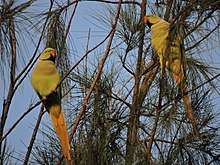
Most of Chandigarh is covered by dense banyan, and eucalyptus plantations. Ashoka, cassia, mulberry and other trees flourish in the forested ecosystem.[38] The city has forests surrounding that sustain many animal and plant species.[39] Deer, sambars, barking deer, parrots, woodpeckers, and peacocks inhabit the protected forests. Sukhna Lake hosts a variety of ducks and geese, and attracts migratory birds from parts of Siberia and Japan in the winter season. The Parrot Bird Sanctuary Chandigarh provides a home to a large number of parrots. Sukhna Wildlife Sanctuary was declared a wildlife sanctuary in 1998.
Gallery
- Junglefowl, Sukhna wildlife sanctuary, Chandigarh
 Sambar deer in City Forest Park,Chandigarh
Sambar deer in City Forest Park,Chandigarh Sambhar deers ,Dhanas lake chandigarh
Sambhar deers ,Dhanas lake chandigarh
Heritage Trees of Chandigarh
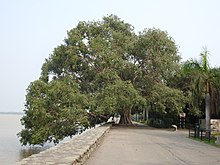
Many trees in Chandigarh are given a status of the natural heritage of the city. The Chandigarh government have identified a list of 31 trees as Heritage Trees. Department of forest & wildlife Chandigarh administration is the nodal department for this purpose which has published a detailed booklet about it. The trees which are 100 years or more old have been given heritage status.
Landscape
Sukhna Lake, a 3 km artificial rain-fed lake in Sector 1,[40] was created in 1958 by damming the Sukhna Choe, a seasonal stream coming down from the Shivalik Hills.[41]
Chandigarh has a belt of parks running from sectors. It is known for its green belts and other special tourist parks. Sukhna Lake itself hosts the Garden of Silence.[42] The Rock Garden,[43][44] is located near the Sukhna Lake and has numerous sculptures made by using a variety of different discarded waste materials.[45] The Zakir Hussain Rose Garden (which is also Asia's largest rose garden) contains nearly 825 varieties of roses in it and more than 32,500 varieties of other medicinal plants and trees.[46] Other gardens include the Garden of Fragrance in Sector 36, Garden of Palms in Sector 42, Butterfly Park in Sector 26, Valley of Animals in Sector 49, the Japanese Garden in Sector 31, the Terraced Garden in Sector 33, Shanti Kunj Garden, the Botanical Garden and the Bougainvillea Garden.[47] There is also a Government museum and art gallery in Sector 10, Chandigarh.
Demographics
| Year | Pop. | ±% p.a. |
|---|---|---|
| 1901 | 21,967 | — |
| 1911 | 18,437 | −1.74% |
| 1921 | 18,133 | −0.17% |
| 1931 | 19,783 | +0.87% |
| 1941 | 22,574 | +1.33% |
| 1951 | 24,261 | +0.72% |
| 1961 | 119,881 | +17.32% |
| 1971 | 257,251 | +7.93% |
| 1981 | 451,610 | +5.79% |
| 1991 | 642,015 | +3.58% |
| 2001 | 900,635 | +3.44% |
| 2011 | 1,055,450 | +1.60% |
| source:[48] | ||
Population
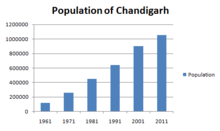
As of 2011 India census, Chandigarh had a population of 1,055,450,[1][2] making for a density of about 9,252 (7,900 in 2001) persons per square kilometre. [49][50]
Males constitute 55% of the population and females 45%. The sex ratio is 818 females for every 1,000 males.[4] The child sex ratio is 880 females per thousand males. Chandigarh has an effective literacy rate of 86.77% (based on population 7 years and above), higher than the national average; with male literacy of 90.81% and female literacy of 81.88%.[4] 10.8% of the population is under 6 years of age.[4] The population of Chandigarh forms 0.09 per cent of India in 2011.[2]
There has been a substantial decline in the population growth rate in Chandigarh, with just 17.10% growth between 2001–2011. Since, 1951-1961 the rate has decreased from 394.13% to 17.10%. This is probably because of rapid urbanisation and development in neighbouring cities.[51] The urban population constitutes as high as 97.25% of the total and the rural population makes up 2.75% as there are only a few villages within Chandigarh on its Western and South-Eastern border and the majority of people live in the heart of Chandigarh.
Languages
Languages of Chandigarh (2011)[52]
English is the sole official language of Chandigarh.[5] The majority of the population speaks Hindi (73.60%) while Punjabi is spoken by 22.03%.[53] Government schools use English, Hindi, and Punjabi textbooks.[54]
Religion
Hinduism is the predominant religion of Chandigarh followed by 80.78% of the population. Sikhism is the second most popular religion in the city, followed by 13.11% of the people. In Chandigarh city Islam is followed by 4.87%. Minorities are Christians 0.83%, Jains 0.19%, Buddhists 0.11%, those that didn't state a religion are 0.10%, and others are 0.02%.[55]
Many institutions serve minorities in the city. One such being the Roman Catholic Diocese of Simla and Chandigarh, serving the Catholics, which even has a co-cathedral in the city, Christ the King Co-Cathedral, although it never was a separate bishopric. Most of the convent schools of Chandigarh are governed by this institution.
Chandigarh hosts many religious places, including Chandimandir, the temple after which it was named. The ISKCON temple in Sector 36 is one of the worship places for Hindus. Nada Sahib Gurudwara, a famous place for Sikh worship lies in its vicinity.[56] Apart from this, there are a couple of historical mosques in Manimajra and Burail.[57]
Economy
Chandigarh has been rated as one of the "Wealthiest Towns" of India.[58] The Reserve Bank of India ranked Chandigarh as the third-largest deposit centre and seventh largest credit centre nationwide as of June 2012. With a per capita income of ₹99,262, Chandigarh is one of the richest cities in India.[59] Chandigarh's gross state domestic product for 2014-15 is estimated at ₹0.29 lakh crore (US$4.3 billion) at current prices. According to a 2014 survey, Chandigarh is ranked 4th in the top 50 cities identified globally as "emerging outsourcing and IT services destinations" ahead of cities like Beijing.[60]
Employment
The government is a major employer in Chandigarh with three governments having their base here i.e. Chandigarh Administration, Punjab government and Haryana government. A significant percentage of Chandigarh's population, therefore, consists of people who are either working for one of these governments or have retired from government service mainly armed forces. For this reason, Chandigarh is often called a "Pensioner's Paradise".[61] Ordnance Cable Factory of the Ordnance Factories Board has been set up by the government of India. There are about 15 medium to large industries including two in the public sector. In addition, Chandigarh has over 2,500 units registered under the small-scale sector. The important industries are paper manufacturing, basic metals and alloys, and machinery. Other industries are relating to food products, sanitary ware, auto parts, machine tools, pharmaceuticals, and electrical appliances.
The main occupation here is trade and business.[62][63] However, the Punjab and Haryana High Court, Post Graduate Institute of Medical Education and Research (PGIMER), the availability of an IT Park, and more than a hundred government schools provide job opportunities to people.
Four major trade promotion organisations have their offices in Chandigarh. These are The Associated Chambers of Commerce & Industry, ASSOCHAM India [64] in Sector 8, Chandigarh, Federation of Indian Chambers of Commerce & Industry, (FICCI) the Ph.D Chamber of Commerce and Industry and the Confederation of Indian Industry (CII) which has its regional headquarters at Sector 31, Chandigarh.[65][66]
Chandigarh IT Park (also known as Rajiv Gandhi Chandigarh Technology Park) is the city's attempt to break into the information technology world. Chandigarh's infrastructure, proximity to Delhi, Haryana, Punjab, and Himachal Pradesh, and the IT talent pool attracts IT businesses looking for office space in the area. Major Indian firms and multinational corporations like Quark, Infosys, EVRY, Dell, IBM, TechMahindra, Airtel, Amadeus IT Group, DLF have set up base in the city and its suburbs.
The work of the Chandigarh Metro was earlier slated to start by the year 2019. It was opposed by the Member of Parliament from Chandigarh, Kirron Kher.[67] With an estimated cost of around ₹10,900 crores including 50% funds from the governments of Punjab and Haryana and 25% from Chandigarh and government of India, funds from the Japanese government were proposed to include approximately 56% of the cost.[68][69] However, the project was turned down owing to its non-feasibility. Kher promised a film city for Chandigarh. After winning the seat, she said that she had difficulty in acquiring land in Chandigarh.[70] Her proposal was accepted by the Chandigarh Administration and the film city is proposed to be set up in Sarangpur, Chandigarh.[71] This has been considered as a source of employment in the future.
Politics
Chandigarh, as a Union Territory, is not entitled to a state-level election: thus State Assembly elections are not held and it is directly controlled by the central government. One seat for Chandigarh is allocated in the Lok Sabha elections held every five years.
The following Members of Parliament have been elected from the Chandigarh constituency:
The city is controlled by a civic administration. In the Municipal Corporation, BJP candidate Arun Sood defeated Congress' Mukesh Bassi by 21-15 votes for the post of Mayor, while BJP's Davesh Moudgil and SAD's Hardeep Singh defeated Congress' Darshan Garg and Gurbax Rawat for the posts of Sr. Deputy Mayor and Deputy Mayor respectively, in the Municipal Corporation's mayoral polls in January 2016.[72] In January 2017 BJP's Asha Kumari Jaswal was elected as the mayor, BJP's Rajesh Kumar Gupta and Anil Dubey were elected as senior deputy mayor and deputy mayor respectively. In January 2019 Mayor elections, BJP candidate Rajesh Kumar Kalia was elected as the Mayor by defeating the independent candidate Satish Kainth by securing 16 votes out of the total 27 votes.[73]
Composition of Chandigarh Municipal Corporation as of February 2017[74]
| Political Party | Number of Councillers | |
|---|---|---|
| Bharatiya Janata Party | 20 | |
| Shiromani Akali Dal | 1 | |
| Indian National Congress | 4 | |
| Independent | 1 | |
| Nominated | 9 | |
| Member of Parliament | 1 | |
| Total | 36 | |
Education

There are numerous educational institutions in Chandigarh. These range from privately and publicly operated schools to colleges. These include Panjab University, Post Graduate Institute of Medical Education and Research (PGIMER), Punjab Engineering College, Post Graduate Government College, Sector 11, Chandigarh, and DAV College.
According to Chandigarh administration's department of education, there are a total of 115 government schools in Chandigarh,[75] including Government Model Senior Secondary School, Sector 16, Jawahar Navodaya Vidyalaya, Bhavan Vidyalaya, convent schools like St. Stephen's School, St. John's High School, Chandigarh, St. Anne's Convent School, St. Kabir Public School, St. Xavier's Senior Secondary School and Carmel Convent School and other private schools like Delhi Public School and D.A.V. Public School.
Transport
Road

Chandigarh has the largest number of vehicles per capita in India.[76] Wide, well-maintained roads and parking spaces all over the city ease local transport.[77] The Chandigarh Transport Undertaking (CTU) operates public transport buses from its Inter State Bus Terminals (ISBT) in Sectors 17 and 43 of the city.[78] CTU also operates frequent bus services to the neighbouring states of Punjab, Haryana, Himachal Pradesh, and to Delhi.
Chandigarh is well connected by road to the following nearby cities, by the following highway routes:
Air
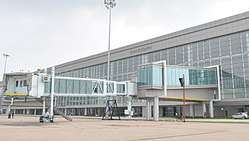
Chandigarh Airport has scheduled commercial flights to major cities of India.
Rail
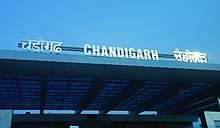
Chandigarh Junction railway station lies in the Northern Railway zone of the Indian Railway network and provides connectivity to most of the regions of India.
Culture
Festivals
Every year, in September or October during the festival of Navratri, many associations and organisations hold a Ramlila event which has been conducted for over 50 years.[79]
The Rose Festival in Zakir Hussain Rose Garden every February shows thousands of subspecies of roses.[80]
The Mango Festival held during the monsoons, and other festivals are held at Sukhna Lake.
Sports
The Sector 16 Stadium has been a venue of several international cricket matches, but it has lost prominence after the PCA Stadium was constructed in Mohali. It still provides a platform for cricketers in this region to practice and play inter-state matches.[81]
The Chandigarh Golf Club has a 7,202-yard, 18-hole course known for its challenging narrow fairways, dogleg 7th hole, and floodlighting on the first nine holes.[82]
Postcolonial significance
Background
Nehru said of Chandigarh when he first visited the site of the new city in 1952: "Let this be a new town, symbolic of the freedom of India, unfettered by the traditions of the past, an expression of the nation's faith in the future".[83] For Nehru, Chandigarh represented a vision for how a new planned city could be a canvas for the regeneration of the nation itself after centuries of oppression under British colonial rule and the dilution of Indian character from the nation's towns. Guided by the architectural optics of Le Corbusier the development of Chandigarh was part of a state-driven exercise to break from the traditions of imperialism in city making and begin the process of healing from the injustices suffered.[84]
To the extent that Chandigarh epitomises the destructive influence of the British, in the impetus of its creation as a solution to the otherwise violent partitioning of territory between India and Pakistan, it represents an early ideological symbol for the birth of India's future. The selection of the physical site involved an extensive vetting process. Many existing towns in Punjab were surveyed as options for the new capital and dismissed for poor performance in relation to factors such as military defensibility and capacity for accommodating potential refugee influxes. The construction of a new town in Chandigarh was determined to be the best option due to its relative strength in these factors as well as its proximity to the national capital, New Delhi, its central location within the state of Punjab, its abundance of fecund land and its beautiful natural landscape.[85]
Modernism in new town design
Off the back of this conflation of assets Chandigarh then was well poised to serve a function as a city-building project in national identity. From a federal policy perspective, the development of the new town became a tool in India for modernisation and an intended driver of economic activity, legal reform, and regional growth as well as a significant agent for the decolonisation project.[86] As Britain's grip on their empire began to weaken their accelerated withdrawal between the beginning of the second world war and 1947 left their former colony in states of disarray and disorganisation, and policymakers for the new Indian government were required to contend with issues such as rapid rural depopulation, urban congestion, and poverty. As well as in Chandigarh this policy tool was implemented in the creation of new capital cities in Bhubaneswar and Gandhinagar, and more broadly throughout India in the 112 planned cities created between independence and 1971, purposed to absorb migration from those regions in demise after being abandoned by the British and provide hubs for growing industries such as in steel and energy.[87]
These examples from a genealogy of utopian urban forms developed in post-independence India as a panacea for issues related to underdevelopment as well as post-independence complications to do with separatist religious conflict and the resulting diplomatic tensions. Chandigarh is the first example of a state-funded master-planned modernisation scheme. These "urban utopias" attempt to enforce nation-building policies through a federalised rule of law at a regional level, and diffuse postcolonial urbanism which codes justice in its design.[88] The intent is that the economic success and progressivism of cities such as Chandigarh as a lightning rod for social change would gradually be emulated at the scale of the nation. Chandigarh was for Nehru and Le Corbusier an embodiment of the egalitarian potential offered by modernism, where the machine age would complete the liberation of the nation's citizens through the productive capacity of industrial technology and the relative ease of constructing civic facilities such as dams, hospitals, and schools; the very antithesis of the conservative and traditional legacy of colonialism.[86] Though built as a state capital Chandigarh came to be focused in industry and higher education.[87] The specialisation of these new towns in particular functions represents a crucial aspect of the modernisation process as a decolonising enterprise, in completing a national portfolio where each town forms a part of the utopian model for contemporary India.
The post-colonialism of Chandigarh is rooted in the transformation of the political ideas of those such as Nehru who generated a new Indian nationalism into the design of newly built forms.[89] Scholars such as Edward Said have emphasised the sinister nature of nostalgia and the romanticisation of colonial architecture in newly independent colonies as artefacts that perpetuate the ideological legacy of the hegemony and replicate the hierarchy of power even after decolonisation.[90] Insofar as modernism in architecture (which defined town planning under the Nehru era of rule) represents an active radical break from tradition and a colonial past even the very presence of Le Corbusier has been recognised as an indelible resistance to the British construction legacy, as he provided the first non-British influence on design thinking in India, enabling a generational shift in the contemporary cohort of architects and planners to be hired by the state throughout the rest of the century who were initiated under Modernist conditioning.[89] As early as the 1950s the presence of the International Style could be detected in the design of houses in India, "whether mistri or architect-designed".[91] The development of low-cost housing was a priority for Chandigarh, and the modern forms designed by Corbusier are characterised by a dispensing with colonial forms focused on classic aesthetics and a refocusing on strategies such as using narrow frontages and orientation for minimising direct exposure to the sun and maximising natural ventilation and efficient cost while providing modern amenities in the International Style aesthetic.[92] These developments are credited as the beginning of a "Chandigarh architecture", inspiring gradual experimentation with form and an "Indianising" of the International Style which precipitated the formation of the country's new cultural identity in town design.[89]
Criticisms
Criticisms are well established of the implementation of the postcolonial vision of Nehru and Le Corbusier, and of the critical emphasis on its influence. Claims have been made that the focus on Corbusier's architect-centered discourse erases the plural authorship of the narrative of Chandigarh's development, arguing that it was, in fact, a hybridity of values and of "contested modernities" of Western and indigenous Indian origin and cultural exchanges rather than an uncontested administrative enterprise.[93] Such criticism is consistent with claims that decolonisation in India has marked a shift from segregation based on race to segregation based on class, and that planned cities are truly "designed" ones which represent the values and interests of a westernised middle-class Indian elite which ignore the complexities of India's diverse ethnic and cultural landscape and enabled neocolonial hierarchies such as the imposition of the Hindi language on non-conforming castes.[84][86][89] Furthermore, the early over-saturation of the minimalist International Style on building design in Chandigarh has attracted criticisms of effecting a "democratic, self-effacing banality", though this criticism is perhaps negligent of how this was necessary in galvanising higher standards of urban living throughout the country.[94]
Notable people from Chandigarh
- Sarbjit Bahga, architect, author, photo-artist
- Binny Bansal, founder of Flipkart, Billionaire.[95]
- Sachin Bansal, founder of Flipkart, Billionaire.[95][96]
- Neerja Bhanot, youngest Ashoka Chakra Awardee, flight attendant and model
- Sabeer Bhatia, Indian-American Entrepreneur who founded Hotmail[97]
- Jaspal Bhatti, Padma Bhushan Awardee, Film and TV Actor and renowned satirist
- Abhinav Bindra, Olympic gold medalist[98]
- Nek Chand, Indian artist and creator of the Rock Garden of Chandigarh[99]
- Surveen Chawla, Punjabi Film Actress
- Gurleen Chopra, Punjabi actress[100]
- Vivek Dahiya, actor
- Harita Kaur Deol, pilot
- Kapil Dev, former Indian international cricketer[101]
- Harmeet Dhillon, American lawyer
- Mukesh Gautam, Punjabi film director
- Yami Gautam, Indian film actress
- Mahie Gill, Indian actress[102]
- Sandesh Jhingan, Indian International Professional footballer
- Mamta Joshi, Sufi singer
- Gurbani Judge, MTV India VJ and actress
- AJ Kanwar, award Winning Dermatologist, Former Professor & Head, PGI, Chandigarh
- Kirron Kher, Indian actress and theatre artist (also BJP M.P. from the city)[103]
- Ayushmann Khurrana, Indian Film actor
- Rochak Kohli, music composer, singer, lyricist
- Aanchal Kumar model, actress
- Sargun Mehta, Punjabi film actress
- Anjum Moudgil, Indian Rifle Shooter
- Prince Narula, actor
- Ramesh Kumar Nibhoria, winner of Ashden Awards-UK[104]
- Gul Panag, Indian film actress and Social Activist[105]
- Neel Kamal Puri novelist, columnist
- Gajendra Pal Singh Raghava, Bioinformatics Scientist[106]
- Kulraj Randhawa, Punjabi Film Actress[107]
- Mohinder Singh Randhawa, Civil Servant who had a major role in establishing Chandigarh
- Mohit Sehgal, TV actor
- Piare Lal Sharma, writer
- Jeev Milkha Singh, professional Golfer[108]
- Milkha Singh Commonwealth gold medalist.[109][110]
- Yuvraj Singh, Indian international cricketer[111]
- Pammi Somal, Bollywood journalist and filmmaker
- Sri Srinivasan, United States Circuit Judge of the United States Court of Appeals for the District of Columbia Circuit
- Manan Vohra, cricketer
See also
- New Chandigarh, Punjab
- Chandigarh capital region
- Mohali
- Panchkula
- Pinjore
- Ambala Chandigarh Expressway
Notes
- see § Etymology
References
- "Chandigarh (India): Union Territory & Agglomeration - Population Statistics in Maps and Charts". Archived from the original on 9 April 2017. Retrieved 6 July 2019.
- "Statistical Abstract of Chandigarh" (PDF). Official Website of Chandigarh. Retrieved 8 June 2020.
- "Provisional Population Totals, Census of India 2011; Urban Agglomerations/Cities having population 1 lakh and above" (PDF). Office of the Registrar General & Census Commissioner, India. Archived (PDF) from the original on 15 December 2011. Retrieved 26 March 2012.
- "Provisional Population Totals, Census of India 2011; Cities having population 1 lakh and above" (PDF). Office of the Registrar General & Census Commissioner, India. Retrieved 26 March 2012.
- "52nd REPORT OF THE COMMISSIONER FOR LINGUISTIC MINORITIES IN INDIA" (PDF). nclm.nic.in. Ministry of Minority Affairs. Archived from the original (PDF) on 25 May 2017. Retrieved 8 July 2019.
- "Used Cars in Mumbai - Second Hand Cars in Mumbai for Sale". Cars24. Retrieved 17 August 2020.
- "Sub-national HDI – Area Database". Global Data Lab. Institute for Management Research, Radboud University. Archived from the original on 23 September 2018. Retrieved 25 September 2018.
- Service, Tribune News (12 October 2015). "Corbusier's creation". www.tribuneindia.com/news/trends/corbusier-s-creation/142344.html. Archived from the original on 15 October 2015. Retrieved 13 October 2015.
- "State Animal, Bird, Tree and Flower of Chandigarh" (PDF). Retrieved 8 June 2020.
- "Business Portal of India : Investment Opportunities and Incentives : State Level Investment : Chandigarh". business.gov.in. Archived from the original on 17 October 2013. Retrieved 12 March 2015.
- "Is this the perfect city?". www.bbc.com. Archived from the original on 16 December 2015. Retrieved 22 December 2015.
- Ajay Deep. "Chandigarh gets the Cleanest City of India title". Archived from the original on 8 December 2015.
- "India's cleanest: Where does your city stand?: Rediff.com News". News.rediff.com. 13 May 2010. Archived from the original on 26 July 2010. Retrieved 26 July 2010.
- Meghalaya Human Development Report 2008 Archived 21 August 2011 at the Wayback Machine (p. 23)
- "Chandigarh 'happiest' city, claims LG survey". 12 June 2015. Archived from the original on 22 December 2015.
- Ajay Deep. "Chandigarh is the Happiest City of India - LG Survey". Archived from the original on 18 December 2015.
- "Chandigarh happiest city in India, Guwahati least: LG Survey". The Economic Times. 11 June 2015. Retrieved 17 September 2019.
- "Tricity residents to get Emaar MGF's Central Plaza soon". The Financial Express. 6 January 2014. Archived from the original on 9 January 2014.
- "CII". cii.in. Archived from the original on 6 April 2015. Retrieved 12 March 2015.
- "Chandigarh: Info on geography, history, government, districts, business, economy, travel, rivers, education, food, arts, culture, music, dance, festivals". newkerala.com. Archived from the original on 17 March 2015. Retrieved 12 March 2015.
- Kalia, Ravi (1987). Chandigarh : in search of an identity. Carbondale: Southern Illinois University Press. p. 54. ISBN 978-0809313105.
- Office of the Registrar General, R. K. Goswami (1970). Census of India, 1971, Series 25, Chandigarh: Census atlas. India. pp. 20, 22, 33.
- "Official website of the Chandigarh Administration". Chandigarh Administration. Retrieved 8 June 2020.
- "Chandigarh history". City Beautiful. Archived from the original on 5 May 2015. Retrieved 21 March 2015.
- "Chandigarh History". Chandigarh Guide. Archived from the original on 21 February 2015. Retrieved 12 March 2015.
- "About Chandigarh". Government of Chandigarh. Archived from the original on 2 June 2011. Retrieved 12 March 2015.
- "Displaced for making Chandigarh, their marginalization is still on". The Times of India. 12 May 2014. Archived from the original on 17 October 2015. Retrieved 21 December 2014.
- Banerjee, Tridib (2009). "U.S. Planning Expeditions to Postcolonial India: From Ideology to Innovation in Technical Assistance". Journal of the American Planning Association. 75 (2). pp. 193–208. doi:10.1080/01944360902790711.
- Frommer's India Archived 5 January 2016 at the Wayback Machine (2010) Pippa de Bruyn, John Wiley & Sons, p613 ISBN 9780470556108
- "Capitol Complex, as Le Corbusier wanted it, remains incomplete". Indian Express. 19 June 2010. Archived from the original on 26 October 2013. Retrieved 2 July 2013.
- "1st November 1966 - Haryana Day". Haryana Online. Archived from the original on 2 October 2013. Retrieved 8 July 2013.
- "villages.pdf" (PDF). chandigarh.gov.in. Archived (PDF) from the original on 23 December 2015. Retrieved 9 September 2015.
- "Falling Rain Genomics, Inc – Chandigarh". Falling Rain Genomics. Archived from the original on 16 January 2009. Retrieved 21 March 2015.
- "Chandigarh > Travel tips > Location". bharatonline.com. Archived from the original on 23 December 2014. Retrieved 26 March 2015.
- "Know Chandigarh". Official Website of Chandigarh Administration. 21 July 2011. Archived from the original on 21 July 2011. Retrieved 2 April 2020.
- "Station: Chandigarh Climatological Table 1961–1990" (PDF). Climatological Normals 1961–1990. India Meteorological Department. July 2010. pp. 179–180. Archived (PDF) from the original on 16 February 2020. Retrieved 31 March 2020.
- "Extremes of Temperature & Rainfall for Indian Stations (Up to 2012)" (PDF). India Meteorological Department. December 2016. p. M64. Archived from the original (PDF) on 5 February 2020. Retrieved 31 March 2020.
- "Chandigarh Forest Flora - Comprehensive Database". Archived from the original on 31 March 2018. Retrieved 8 December 2018.
- "Official Website of Chandigarh Administration". chandigarh.gov.in. Archived from the original on 21 October 2014. Retrieved 12 March 2015.
- "Archived copy". Archived from the original on 15 March 2016. Retrieved 1 August 2017.CS1 maint: archived copy as title (link)
- "Sukhna Lake - Chandigarh Sukhna Lake - Sukhna Lake of Chandigarh India". chandigarh.co.uk. Archived from the original on 16 January 2015. Retrieved 21 March 2015.
- "The Garden of Silence – quieter end of Sukhna Lake". kiboli.wordpress.com. Wordpress. 4 July 2012. Archived from the original on 23 December 2014. Retrieved 21 March 2015.
- "Nek Chand's Rock Garden in Chandigarh". pnrstatusirctc.in. 10 June 2017. Archived from the original on 5 August 2017.
- "About Nek Chand". Archived from the original on 17 February 2015. Retrieved 21 March 2015.
- "Rock Garden". Archived from the original on 9 January 2015. Retrieved 21 March 2015.
- "Rose Garden of Chandigarh". Archived from the original on 23 March 2015. Retrieved 21 March 2015.
- "Official Website of Chandigarh Administration". Archived from the original on 28 January 2015. Retrieved 21 March 2015.
- "Census of India Website : Office of the Registrar General & Census Commissioner, India". www.censusindia.gov.in. Retrieved 29 December 2019.
- "Census of India Website : Office of the Registrar General & Census Commissioner, India". censusindia.gov.in. Archived from the original on 11 May 2008. Retrieved 12 March 2015.
- "Census observations". Census of India. www.ssachd.nic.in. Archived from the original on 24 January 2016. Retrieved 7 February 2016.
- "Chandigarh demographics" (PDF). chandigarh.gov.in. Archived (PDF) from the original on 13 May 2015. Retrieved 21 March 2015.
- "Language – India, States and Union Territories" (PDF). Census of India 2011. Office of the Registrar General. pp. 13–14. Retrieved 24 November 2018.
- "After mother tongue, city more proficient in English". 3 October 2018. Archived from the original on 4 October 2018. Retrieved 4 October 2018.
- "List of Text Books Prescribed for Classes I to X in Government Non-Model Schools of Chandigarh (UT) for the Session 2007-08" (PDF). Chandigarh Administration Education Department. Archived (PDF) from the original on 15 August 2011. Retrieved 21 March 2017.
- "Archived copy" (PDF). Archived (PDF) from the original on 21 August 2017. Retrieved 28 July 2017.CS1 maint: archived copy as title (link)
- "Religious Places in Chandigarh". chandigarh.co.uk. Archived from the original on 17 October 2015. Retrieved 9 September 2015.
- "Masjids in Chandigarh". google.co.in. Retrieved 9 September 2015.
- Chandigarh has been rated as the "Wealthiest Town" of India.http://chandigarh.gov.in/knowchd_redfinechd.htm
- "Chandigarh's the richest of 'em all". IBNLive. Archived from the original on 24 September 2008. Retrieved 12 March 2015.
- "6 Indian cities among emerging outsourcing hubs". The Hindu Business Line. Archived from the original on 6 January 2011. Retrieved 12 March 2015.
- "IAS OUR DREAM - Chandigarh is often called a "Pensioner's... - Facebook". facebook.com. Archived from the original on 17 October 2015. Retrieved 12 March 2015.
- Occupation in Chandigarh Archived 23 December 2014 at the Wayback Machine. The people of Chandigarh and their occupation.
- Chandigarh people, culture and occupation Archived 23 December 2014 at the Wayback Machine. The culture and people of Chandigarh.
- The Associated Chambers of Commerce & Industry, ASSOCHAM India
- CII (NR) headquarters are at Chandigarh Archived 10 February 2015 at the Wayback Machine. (Confederation of Indian Industry) The headquarters of CII North Region are at Chandigarh.
- Confederation of Indian Industry Archived 3 April 2015 at the Wayback Machine. The Headquarters of CII (NR) are at Chandigarh.
- "Metro not feasible for city: MP". Chandigarh Tribune. The Tribune. Archived from the original on 9 September 2014. Retrieved 25 March 2015.
- Ajay Deep (15 October 2014). "Chandigarh Metro Project Cost and Other Details". Chandigarh Metro. Archived from the original on 15 March 2015. Retrieved 12 March 2015.
- "Chandigarh Metro - Know what's happening in Chandigarh". Chandigarh Metro. Archived from the original on 14 March 2015. Retrieved 12 March 2015.
- Press Trust of India (25 August 2014). "Trying to get Film City for Chandigarh soon: Kirron Kher". business-standard.com. Archived from the original on 13 November 2014. Retrieved 12 March 2015.
- "Official Website of Chandigarh Administration". chandigarh.gov.in. Archived from the original on 12 November 2014. Retrieved 12 March 2015.
- "BJP-SAD wins all top posts in Chandigarh MC polls". The Tribune. Archived from the original on 10 January 2016. Retrieved 9 January 2016.
- "Rajesh Kalia new Mayor of Chandigarh". The Hindu. 18 January 2019. Retrieved 28 July 2019.
- "BJP Sweeps Chandigarh Municipal Polls, Amit Shah Calls It Vote For Notes Ban". NDTV. Archived from the original on 21 December 2016. Retrieved 20 December 2016.
- "Government Schools | Department of Education Chandigarh Administration". chdeducation.gov.in. Retrieved 20 February 2020.
- "Top Ten Towns with Highest Number of Car Ownership in India". mapsofindia.com. Archived from the original on 24 February 2015. Retrieved 12 March 2015.
- "Chandigarh city guide, information, history, weather, geographic statistics". citcochandigarh.com. Archived from the original on 10 March 2015. Retrieved 12 March 2015.
- "Chandigarh Transport Undertaking". Archived from the original on 18 March 2015. Retrieved 21 March 2015.
- "60 venues to stage Ramlila in Chandigarh this year". The Hindustan Times. HT Correspondents. HT Media. 1 October 2016. Archived from the original on 4 December 2017. Retrieved 19 September 2017.
- "ROSE GARDEN". chandigarhtourism.gov.in. Chandigarh govt. Archived from the original on 18 May 2015. Retrieved 11 December 2014.
- "Sector 16 Stadium - India - Cricket Grounds - ESPN Cricinfo". Cricinfo. Archived from the original on 5 May 2015. Retrieved 12 March 2015.
- "Chandigarh Golf Club (CGC) - Golf in Punjab - Haryana golf - North India Golf - Golfgaga – Where golfers meet! - Jeev Milka Singh Home Course - India's Top golfers - Golf courses in India". golfgaga.com. Archived from the original on 25 March 2015. Retrieved 12 March 2015.
- "Chandigarh Exhibited in New York". Wall Street Journal. Archived from the original on 1 January 2017. Retrieved 7 April 2019.
- Kalia, Ravi (1990). Chandigarh: The making of an Indian city. New Delhi: Oxford University Press. p. 5. ISBN 978-0-195-65030-3.
- "Historical Background". Government of Chandigarh. Archived from the original on 19 May 2011. Retrieved 7 April 2019.
- Kalia, Ravi (2004). Gandhinagar: Building National Identity in Postcolonial India. Columbia: Univ of South Carolina Pres. p. 2. ISBN 978-1-570-03544-9.
- K. C. Sivaramakrishnan (1976–1977). New Towns in India: A Report on a Study of Selected New Towns in the Eastern region (PDF) (Report). Indian Institute of Management Calcutta. p. 4. Archived (PDF) from the original on 16 May 2018. Retrieved 12 April 2019.CS1 maint: date format (link)
- Datta, Ayona. "New urban utopias of postcolonial India: 'Entrepreneurial urbanization' in Dholera smart city, Gujarat" (PDF). Dialogues in Human Geography. 5 (1): 4. doi:10.1177/2043820614565748. S2CID 54070842.
- Shaw, Annapurna (2009). "Town Planning in Postcolonial India, 1947-1965: Chandigarh Re-Examined". Urban Geography. 30 (8): 864–873. doi:10.2747/0272-3638.30.8.857. S2CID 145266110.
- James-Chakraborty, Kathleen (2014). "Beyond postcolonialism: New directions for the history of nonwestern architecture". Frontiers of Architectural Research. 3 (1): 2. doi:10.1016/j.foar.2013.10.001.
- Lang, Jon; Desai, Madhavi; Desai, Miki (1997). Architecture and Independence: The Search for Identity—India 1880 to 1980. New York, NY: Oxford University Press, USA. p. 213. ISBN 978-0-195-63900-1.
- Jackson, Iain (2013). "Maxwell Fry and Jane Drew's early housing and neighborhood planning in Sector-22, Chandigarh". Planning Perspectives. 28 (1): 12. doi:10.1080/02665433.2013.734993. S2CID 143917493.
- Perera, Nihal (2004). "Contesting visions: hybridity, liminality, and authorship of the Chandigarh plan". Planning Perspectives. 19 (2): 178. doi:10.1080/0266543042000192466. S2CID 220332059.
- Bhatt, Vikram; Scriver, Peter (1990). Contemporary Indian Architecture: After the Masters. Ahmedabad, India: Mapin. p. 15. ISBN 978-0-944-14219-6.
- "Mukesh Ambani India's richest for 9th year; Flipkart's Bansals new entrants - Latest News & Updates at Daily News & Analysis". 24 September 2015. Archived from the original on 4 October 2015. Retrieved 16 October 2015.
- "From Rs 10,000 to $1-bn: The journey of Sachin & Binny Bansal's Flipkart". The Economic Times. Archived from the original on 3 April 2015. Retrieved 12 March 2015.
- "Sabeer Bhatia – "The HotMale behind Hotmail"". iammadeinindia.com. Archived from the original on 11 March 2015. Retrieved 12 March 2015.
- "Abhinav Bindra - Rifle shooter, picture, profile, info and favourites". Archived from the original on 25 March 2015.
- "About the Foundation". nekchand.com. Archived from the original on 17 February 2015. Retrieved 12 March 2015.
- "Bollywood Celebrity". Archived from the original on 14 December 2014. Retrieved 12 March 2015.
- "Kapil Dev Profile". indiaonlinepages.com. Archived from the original on 17 February 2015. Retrieved 12 March 2015.
- "Mahi Gill". Bollywood Dhamaal. Archived from the original on 5 May 2015. Retrieved 12 March 2015.
- "Kiron Kher". FilmiBeat. Archived from the original on 14 December 2014. Retrieved 12 March 2015.
- "DSIR > Programmes > Erstwhile Programmes > TePP - Technopreneur Promotion Programme > tepp". csir.res.in. Archived from the original on 14 December 2014. Retrieved 12 March 2015.
- "Gul Panag". FilmiBeat. Archived from the original on 14 December 2014. Retrieved 12 March 2015.
- "Notable bioinformatician - Dr Gajendra Pal Singh Raghava". biospectrumindia.com. Archived from the original on 28 April 2015. Retrieved 12 March 2015.
- "Kulraj Randhawa works with Dharmendra again". The Times of India. Archived from the original on 17 October 2015. Retrieved 21 March 2015.
- "Jeev Milkha Singh Profile". iloveindia.com. Archived from the original on 9 April 2015. Retrieved 12 March 2015.
- "Milkha Singh at his residence". indiatimes.com. Archived from the original on 1 January 2015. Retrieved 12 March 2015.
- Sandeep Singh Bajwa. "Sikh Sports personality Flying Sikh Milkha Singh". sikh-history.com. Archived from the original on 25 February 2015. Retrieved 12 March 2015.
- Arjun (17 August 2011). "Short Biography of cricketer Yuvraj Singh". preservearticles.com. Archived from the original on 14 December 2014. Retrieved 12 March 2015.
Further reading
- Fynn, Shaun. Chandigarh Revealed: Le Corbusier's City Today. Princeton Architectural Press, 2017. ISBN 9781616895815
- Evenson, Norma. Chandigarh. Berkeley, CA: University of California Press, 1966.
- Sarbjit Bahga, Surinder Bahga (2014) Le Corbusier and Pierre Jeanneret: The Indian Architecture, CreateSpace, ISBN 978-1495906251
- Joshi, Kiran. Documenting Chandigarh: The Indian Architecture of Pierre Jeanneret, Edwin Maxwell Fry and Jane Drew. Ahmedabad: Mapin Publishing in association with Chandigarh College of Architecture, 1999. ISBN 1-890206-13-X
- Kalia, Ravi. Chandigarh: The Making of an Indian City. New Delhi: Oxford University Press, 1999.
- Maxwell Fry and Jane Drew. Chandigarh and Planning Development in India, London: Journal of the Royal Society of Arts, No.4948, 1 April 1955, Vol. CIII pages 315–333. I. The Plan, by E. Maxwell Fry, II. Housing, by Jane B. Drew.
- Nangia, Ashish. Re-locating Modernism: Chandigarh, Le Corbusier and the Global Postcolonial. Ph.D. Dissertation, University of Washington, 2008.
- Perera, Nihal. "Contesting Visions: Hybridity, Liminality, and Authorship of the Chandigarh Plan" Planning Perspectives 19 (2004): 175–199
- Prakash, Vikramaditya. Chandigarh’s Le Corbusier: The Struggle for Modernity in Postcolonial India. Seattle: University of Washington Press, 2002.
- Sarin, Madhu. Urban Planning in the Third World: The Chandigarh Experience. London: Mansell Publishing, 1982.
External links
- Government
- General information
- Chandigarh Encyclopædia Britannica entry
- Chandigarh at Curlie

